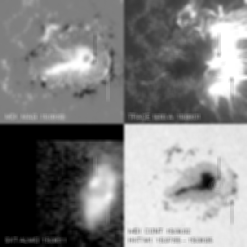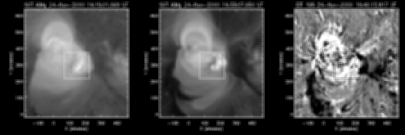Weekly Notes from the Yohkoh Soft X-Ray Telescope
(Week 11, 2002)
Science Nugget: March 15, 2002
Small-scale flux emergence
and flare-CME events
Introduction
More than a year ago, we reported on the recurrence
of six flare-CME events from an active region, and indicated that the
vigorous flux emergence may be a key to this phenomenon. The region showed
very dynamic changes around the leading sunspot, with lots of small magnetic
features coming and going. In the meantime, the story made a
press release at NASA Goddard Space Flight Center, on the basis of
a
published paper. Because of the obvious flux increase, we thought that
the small magnetic features were not so-called moving magnetic features
(MMFs). According to Harvey
and Harvey (1973), who invented the term MMF, MMFs are associated only
with decaying suspot.
Recently, Zhang
and Wang studied the same region and argued that MMFs are an important
ingredient for the homologous CMEs, together with "active region loops"
which are comparable to the extent of coronal dimming. They proposed that
emerging flux in the form of MMFs carry twist, which is transferred to
the active region loops. While the basic idea may contain some truth, we
enconter some difficulties which are given in the following.
Relation of MMFs with UV brightenings and flares
The Zhang and Wang article concentrated on the first flare-CME event in
the series. One of their statements is that UV brightenings as observed
in TRACE 1600 Å data are correlated with the disappearances of MMFs
due to cancellation. Cancellation represents magnetic reconnection of unconnected
opposite polarities at the photospheric level. The images below (click
to enlarge) compare TRACE and MDI data prior to the second event, in an
attempt to associate UV bright points with pairs of opposite polarities
(white: positive, black: negative).

Indeed, one may say that all the encircled UV bright points (the leftmost
image) are close to mixed polarities in the middle figure (magnetogram).
But we should note that such mixed polarity areas are everywhere. In order
to know which pairs are MMFs and which pairs are unconnected, it is necessary
to trace the evolution of individual pairs. We will show a magnetogram
movie from MDI. But before that, we point out that the UV bright points
do not appear to be "the early appearances of the flare" as claimed, as
far as the second flare is concerned -- see the next figure.

This figure shows where the flare foot-points are located (see the arrows)
on the basis of images in three wavelengths. The bottom panels show SXT
and HXT images, respectively. We remember in certain cases SXT soft X-ray
images taken in the early phase of a flare show emission from areas close
to foot-points. An HXT 23-33 keV image is shown (bottom right) in contours
on top of an MDI continuum image. We note that the main flare loop is not
really associated with the UV brightenings, and that one foot-point is
located close to the sunspot umbra. Interestingly, MDI magnetograms recorded
spurious signals due to the flare (top left), and they probably represent
the flare foot-points, consistent with the locations in the HXT image.
Note that all three X-class flares on 24 November showed this artifact
in MDI magnetograms, at nearly the same locations. Furthermore, the flares
also left signals in MDI continuum images, i.e., they are white-light flares
(cf.
last
week's nugget.) As usual, TRACE 1600 Å data also show features
other than the main flare loop (the image at top right is saturated.)
Relation between the flare and the dimming
The relation of the flare and the associated CME is always a tricky business,
because we still do not know for sure what the low coronal signatures are
for CME initiation. But if we assume that coronal dimming represents the
foot prints of the CME loop or the "flux rope," then the following figure
may indicate the relation. Although, empirically, dimming seen in EIT images
is well correlated with CMEs, it is always better to look for dimming at
different wavelengths to ensure that dimming is not a temperature effect.
An increase (or decrease) of temperature off the instrument sensitivity
range will lead to the disappearance of features. Here we compare SXT and
EIT data, and find that the dimming areas match. The box indicates the
field of view of the figures given above. It is not clear what the
toplogical relation is between what appear to be MMFs and the hypothetical
loops connecting the two dimming regions.

Unusual MMFs
A movie of MDI magnetograms, taken from full disk data, was given in
the
previous nugget. In the following we show a movie of MDI high-resolution
magnetograms taken during November 23/24. In order to make it lighter
on computer memory and more importantly to increase the signal to noise
ratio, we did 15-minute averaging; the original data were taken every minute.
We the confirm very dynamic changes in the area (the "moat") surrounding
the sunspot, and find different patterns from those described by Harvey
and Harvey and others in such a way that (1) the motion is not always radial,
and that (2) the magnetic features do not necessarily cancel and disappear
at the moat outer boundary, (3) where the flux (notably the negative polarity,
opposite to the sunspot polarity) builds up. More importantly, (4) there
is a persistent azimuthal motion, clockwise in a area west of the spot,
the area at which a flare foot-point is located. Therefore, we conclude
that the major flare/CME activity started only on November 24, by which
time enough magnetic flux (and shear) accumulated to the west of the sunspot,
even though the MMF activity started on the 23rd.

Conclusions
There have been several published analyses on MMFs since the 1970s, and
different authors emphasized different results as to how the MMF bipolar
patterns are seen with respect to the radial direction, what evolution
MMFs take, and how MMFs are correlated with coronal activity. But there
is a possibility that apples and bananas were compared, that is "MMFs"
may mean a range of things as long as there are outwardly moving magnetic
features. In our region, it seems to be the flux emergence and the accumulated
shear west of the sunspot that were a direct cause of the repeated CME/flare
events. We acknowledge an interesting work by
V.
Yurchyshyn et al., who suggested the possible correlation between the
behavior of MMFs and the twist of the sunspot.
[Topical
index] -o- [Chronological
index]
March 15, 2002
N. Nitta (NVN) (nitta@lmsal.com)